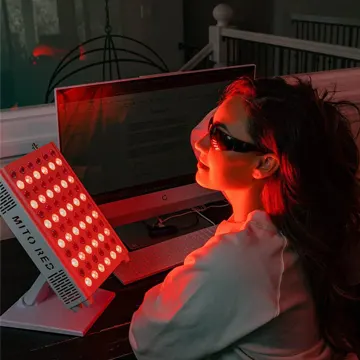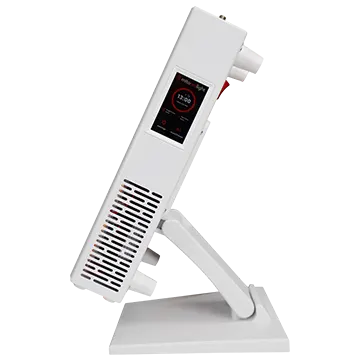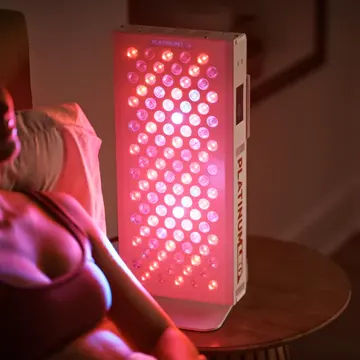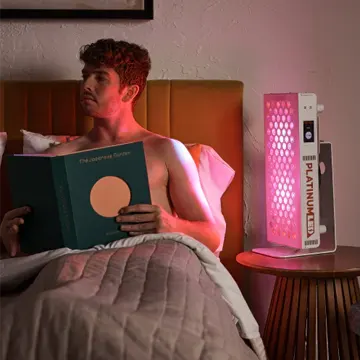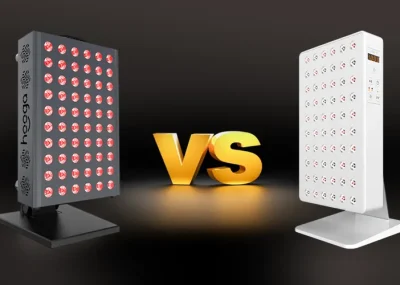Introduction
Red Light Therapy has been on the market for a while owing to its potential health benefits in tackling different health concerns.
If you are looking to improve your sleep, enhance your skin health, fade the appearance of fine lines and wrinkles, or boost recovery from exercise, incorporating red light therapy into your routine could be the answer.
According to researchers Alexander Wunsch and Karsten Matuschka, Medical Light Consulting, Heidelberg, Germany, LED lights are both effective and safe for skin rejuvenation and intradermal collagen increase when compared to controls.
There are lots of Red Light Therapy devices designed by various brands. Here, we will narrow down our scope to two devices: MitoADAPT MIN vs BIOMAX 300. To help you pick the best device for your unique needs, we will look at the features, key benefits, price, safety, and of course, customer reviews.
What Are MitoADAPT MIN Vs BioMAX 300?
MitoADAPT MIN
The MitoADAPT MIN is a 12 by 9 inch red light therapy panel under the MitoADAPT series of products. Just like its fellow devices, it offers an innovative approach to red light therapy through its two distinct features.
One, it uses four different types of LEDs (light emitting diodes) that enable the use of eleven combinations of wavelengths.
Two, MitoADAPT MIN is integrated with a smartphone app that allows you to track your outcome and determine which wavelength combinations are best suited for you. Thanks to this feature, you can optimize your sessions to reap maximum benefits.
The MitoADAPT MIN panel is equipped with four buttons that allow you to customize its settings. You can set the timer and adjust the power intensity anywhere from 1% to 100%.
BioMAX 300
The BioMAX 300 is the main tabletop red light therapy panel by PlatinumLED. It features a sleek and highly responsive touchscreen control panel, first introduced in their second-generation model. The version shown here is part of the third-generation, 2023 edition, showcasing further enhancements.
It is a large panel standing at 19 inches tall and 9 inches across. Since it is larger than its tabletop counterparts, it is also heavier.
BioMAX 300 uses six different wavelengths of both red light and near infrared light. 80% of the light is directed to the 660nm (red light) and 850nm (near infrared light), while the 20% is shared among the other four remaining wavelengths.
Similar to the MitoADAPT MIN, BioMAX 300 also includes an app that lets you control the panel from your phone.
Feature Comparison
The primary difference between the MitoADAPT and BioMAX 300 lies in features such as:
- Size – the BioMAX 300 is much larger than the MitoADAPT MIN. With an area of 1103 cm2 (171 square inches), it almost doubles MitoADAPT MIN’s 697 cm2 (108 square inches) area. Owing to their size difference, the MitoADAPT MIN panel may be better for treating smaller areas while the BioMAX 300 is more suitable to cover larger parts of the body.
- LED count – the BioMAX 300 takes the lead again in this category. It has 100 LEDs while MitoADAPT MIN has 72 LEDs. However, the MitoADAPT MIN uses dual-chip LEDs which means that each lens has two diodes to emit light more evenly.
- Wavelengths – BioMAX 300 has six different wavelengths; 480nm, 630nm, 660nm of red light and 810nm, 830nm, and 850nm near infrared light. As for the MitoADAPT, it uses four different wavelengths that deliver eleven different modes including red light only, near infrared only, or a combination of both.
- Blue light – the BioMAX 300 has two LEDs with blue light which is beneficial for skin health. The blue LEDs are spread out and could offer better results if the lights were close together. MitoADAPT has no blue light.
- Power output – the MitoADAPT MIN emits 42 milliwatts per one squared centimeter (mW/cm2) and 21 watts of therapeutic red light while the BioMAX 300 has a power output of 70 mW/cm2 and 47 watts of therapeutic red light. Gauging by their power output, BioMAX 300 emits more therapeutic light.
- Ease of use – the BioMAX 300 has touchscreen control panel that is very responsive. The screen is quite big and pretty straightforward to use. You can alter power intensities, red light or infrared wavelengths, or power using the control panel. On the other hand, the MitoADAPT MIN has four buttons to operate the panel settings. It has a small screen that is not a touch screen and has lower resolution compared to that of the BioMAX 300.
Outstanding Key Benefits
Red light therapy devices have numerous health benefits. While MitoADAPT MIN and BioMAX 300 have unique features and advantages, they offer these key benefits:
Improves Local Blood Circulation
These devices help stimulate mitochondria using low-energy red light to boost cell function and trigger blood flow. Red light therapy can also promote the growth of new blood vessels that increase blood, oxygen and nutrient supply to the skin. Wavelengths of 630nm to 700nm are optimal for this function.
Relieves Pain and Stiffness
With improved blood flow and nutrient supply to the pain areas, pain and stiffness may be relieved. An author manuscript published in the AIMS Biophysics journal established that photobiomodulation which is the use of red and near-infrared light to relieve pain, stimulate healing and reduce inflammation was effective.
Supports Cellular Function
Red light therapy can help stimulate cells by powering the mitochondria to produce more energy that is then directed to functions such as cell regeneration, muscle and tissue repair, pain relief reduce inflammation, and skin rejuvenation.
Enhances Skin Rejuvenation
These devices are popular for their skin rejuvenating potential. Red light therapy can enhance the skin’s appearance by increasing collagen production, reducing the appearance of fine lines and wrinkles, fading dark spots, reducing redness, and improving facial texture.
Diminishes Acne Breakouts
While red light therapy can help reduce acne scarring, it does not have the antibacterial effects that blue light therapy offers. Studies in the Indian Dermatology Online Journal provide that blue light or blue-red light of 405 to 420nm applied for 8 to 20 minutes twice weekly for four weeks reduces inflammatory acne lesions by 60% to 70%.
Promotes Wound Healing
Since red light therapy improve cellular function, increase blood circulation, and reduce inflammation, it can also promote wound healing.
The Anais Brasileiros De Dermatologia journal reviewed multiple studies to establish whether phototherapy (LASER or LED) was effective in promoting skin wound healing and found that it is effective.
These therapeutic resources worked to decrease inflammatory cells, increase fibroblast proliferation, angiogenesis stimulation, and increase collagen synthesis.
Price Comparison
The MitoADAPT MIN costs $549.00 with free shipping while the BioMAX 300 costs $659.00 plus shipping cost of around $30.00 making it the pricier option. However, BioMAX 300 offers more coverage and uses as it incorporates both near-infrared light and blue light therapy.
While the BioMAX 300 seems to be a pricier option, it offers the best cost per watt. It offers $13 per watt compared to MitoADAPT MIN’s $25 per watt.
Are They Safe?
According to the American Academy of Dermatology (AAD), red-light LED devices are generally considered safe for short term use.
Studies cited by the organization proved the effectiveness of these devices leading to the U.S. Food and Drug Administrations to clear several red-light devices. Both MitoADAPT MIN and BioMAX 300 are class II FDA certified, meaning they have been approved.
Nonetheless, AAD recommends more research to be conducted to provide answers to:
- Is red light safe in the long term?
- What is the optimal number of treatments for concerns such as crow’s feet?
- What is the most effective and safest amount of red light for at-home sessions?
What is the Customer Feedback?
MitoADAPT MIN
I have been using this for a month and I am so happy I purchased this unit. I am starting to feel better (more energy, less pain, more confidence) and I am so hopeful that this will even make me feel better in the coming weeks and months. I use it 1-2 a day with a 6-hour space in between. Give this a try. You will not be sorry! – Jonathan
Helps with muscle recovery. Sleeping better at night. Helps skin. – Brittany
Not good so far. If I don’t start seeing any results or I am able to connect to Bluetooth I will probably return it soon. – Angela
BioMAX 300
The stand is very sturdy and allows you to create different angles, depending on when you are using it. – Holly
Well made, great results from using it. Healed a broken foot without having to do surgery. Great for muscle aches and stiffness. Customer service and overall purchase experience has been wonderful – Tony
I am enjoying the process but have not noticed much change yet. I have had my red light for a couple of weeks. – Kathleen
Conclusion
Going by the size, power output, and wavelengths, we can say the BioMAX 300 takes the top position. It has additional near-infrared and blue light therapy which is not available in the MitoADAPT MIN, meaning it offers more health benefits as well.
At face value, the MitoADAPT MIN seems cheaper, but if you consider the cost-per-watt the BioMAX 300 beats it. The cost-per-watt for the MitoADAPT MIN is $25 per watt while for BioMAX 300 is $13 per watt (without the stand), or $15 per watt (with the stand), or $16 per watt (with the articulating arm stand). In all cases, the BioMAX 300 takes the lead.
Considering customer reviews, the BioMAX 300 also tops with a whopping 4.94 out of 5-star rating compared to MitoADAPT MIN’s 4.6-star rating. Customers love BioMAX 300’s quality, sturdiness and power while MitoADAPT MIN customers appreciate the product’s portability and effectiveness for targeted areas.
There you have it! BioMAX 300 takes the lead on all fronts. Although its size may be considered a shortcoming by some users, it still has the most advantages. However, if you are still focused on a device that is not as big as the BioMAX 300 and offers targeted light therapy, then the MitoADAPT MIN is also worth trying.
Whichever device you pick, ensure to follow the instructions provided by the manufacturers to avoid adverse effects such as skin discoloration. Do not extend usage against the prescribed dose as it may not offer fast results, but instead may cause serious issues.
So, now that you have all this information, what are you waiting for? Head over to the official website and make your purchase!
**This is a subjective assessment based on the strength of the available information and our estimation of efficacy.
*Result may vary. The information contained in this website is provided for general informational purposes only. No medical claims are implied in this content, and the information herein is not intended be used for self diagnosis or self treatment of any condition.
Disclosure of Material connection: Some of the links in the post above are "associate sales links." This means if you click on the link and purchase an item, we will receive commission. Regardless, we only recommend products or services which we use personally and/or believe will add value to our readers. We are disclosing this in accordance with the Federal Trade Commission's 16 CFR, Part 255: "Guides Concerning the Use of Endorsements and Testimonials."



